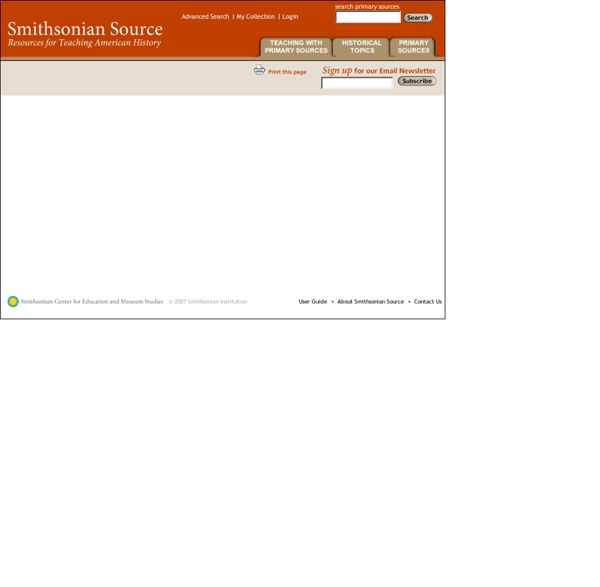



Louvre UH - Digital History National Art Inventories What are the Inventories? The Inventories of American Painting and Sculpture document more than 400,000 artworks in public and private collections worldwide. The Inventory of American Paintings includes works by artists who were active in America by 1914. The Inventory of American Sculpture has no cut-off date and includes works from the colonial era through contemporary times. These online databases are supplemented by a photographic collection of over 80,000 images. Report, Change or Add Art to Inventories We have compiled the Inventories from exhibition and collection catalogs; reports received from individuals, collectors, and family members; and data gathered from special surveys-including the Save Outdoor Sculpture! Daily we add and update records in the Inventories, so we welcome your additions and corrections. Contact Us Please send us your comments and suggestions. Written queries can be addressed to
The 2012 Statistical Abstract What is the Statistical Abstract? The Statistical Abstract of the United States, published since 1878, is the authoritative and comprehensive summary of statistics on the social, political, and economic organization of the United States. Use the Abstract as a convenient volume for statistical reference, and as a guide to sources of more information both in print and on the Web. Sources of data include the Census Bureau, Bureau of Labor Statistics, Bureau of Economic Analysis, and many other Federal agencies and private organizations. The U.S. Sources of Data The Abstract is also your guide to sources of other data from the Census Bureau, other Federal agencies, and private organizations. [Excel] or the letters [xls] indicate a document is in the Microsoft® Excel® Spreadsheet Format (XLS). available for free from Microsoft®. denotes a file in Adobe’s Portable Document Format. available free from Adobe. indicates a link to a non-government web site.
History General History Resources American Experience Access to PBS series about American history. Many programs are available online. American Historical Association As the professional organization for historians, the AHA advocates for the profession and provides information, awards and grants, and resources for educators. Archiving Early America This site provides historical documents from 18th century America. A Biography of America This site was designed to be a self-contained college-level history course. Center for History and New Media Links to general history resources as well as specific events. Discover History The National Park Service offers links to Features of People, Places & Stories and Features of Preservation, Guidance & Grants. History & Social Studies This site from the National Endowment for the Humanities provides lesson plans about American history. History Collection University of Pennsylvania Libraries' links to resources with text archives and image sites. National History Day U.S.
The University of Oklahoma College of Law: A Chronology of US Historical Documents Links marked with an asterisk (*) are to other websites and will open in a new window. Pre-Colonial To 1600 The Magna Carta (1215) Letter from Christopher Columbus to the King & Queen of Spain (1490's) The *Iroquois Constitution 17th Century 18th Century The Albany Plan of 1754 The Resolutions of the Stamp Act (Oct. 19, 1765) 19th Century First Inaugural Address of President Thomas Jefferson (1801) Second Inaugural Address of President Thomas Jefferson (1805) The *Thomas Jefferson Papers at the Library of Congress *Thomas Jefferson Online Resources at the University of Virginia Information on *Monticello First Inaugural Address of President James Madison (1809) Second Inaugural Address of President James Madison (1813) The text of the Star Spangled Banner (Sept. 20, 1814) First Inaugural Address of President James Monroe (1817) Second Inaugural Address of President James Monroe (1821) The Monroe Doctrine (Dec. 2, 1823) Inaugural Address of President *Rutherford B.
Post Secondary Prep The Students.gov website was retired on October 2, 2011. You can find the information and resources listed on Students.gov at the following websites: USA.gov—The U.S. government's official Web portal to federal, state, and local government Web resources and services.CareerOneStop—Your pathway to career success. This site provides tools to help job seekers, students, businesses, and career professionals.
General History Resources General History Web Sites and Resources PBS Online PBS has a great source for information on a myriad of historical events and personalities. PBS’s assorted and diverse web exhibits supplement specific individual television series and generally include a resume of each episode, interviews (often with sound bites), a timeline , a glossary, photos, and links to relevant sites. Categories include American History, World History, History on Television, and Biographies. Go to the PBS Teacher Source for lessons and activities. Center for History and New Media CHNM produces historical works in new media, tests their effectiveness in the classroom, and reflects critically on the success of new media in historical practice. SCORE The Schools of California Online Resources for Educators (SCORE) project is a terrific resource for teachers and students alike. BBC: History BBC’s History section offers an impressive array of exhibitions, activities, games, photo galleries and other resources.